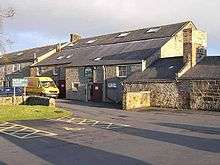Otterburn Mill
Otterburn Mill is a mill in Otterburn, Northumberland, northeast England. It lies just south of the Otterburn Tower along the A696 road next to a bridge over the River Rede.[1]It was owned by the Waddell family for many years and is over 250 years old.[2] The mill is noted for its pram rugs and its crowning moment was on the birth of Princess Elizabeth in 1926, when Buckingham Palace contacted the mill requiring a small rug for the royal pram. It is now a retail outlet, with a restaurant and coffee shop and nursery.

History

Dating from the 18th century,[3] Otterburn Mill was leased in 1821 to William Waddell. (Waddel, the son of a Jedburgh wool manufacturer, had recently arrived in the area having eloped across the border from Scotland with a young bride).[4] What began as a cottage industry grew, under successive generations of Waddels, into a factory-based operation as production became increasingly mechanised.
In the twentieth century, Otterburn Mill became 'a brand leader in woven cloths';[4] its distinctive tweeds were used by some of the leading fashion houses of Europe, including Dior, Balmain, Schiaparelli and Paquin.[4] They were also popular for rural pursuits among the aristocracy and Queen Alexandra was a keen purchaser of the mill's wares.[5]
By the 1970s the textile industry in Britain had gone into decline; manufacturing ceased at Otterburn in December 1976. Twenty years later John Waddel sold the buildings to Euan Pringle; they were converted for retail, with historic machinery and other items retained for display.[6]
Gallery
 This water turbine powered the mill from 1890 until the 1950s (replacing a pair of water wheels).
This water turbine powered the mill from 1890 until the 1950s (replacing a pair of water wheels). Fulling stocks (19th century).
Fulling stocks (19th century). A Cornish boiler provided hot water and steam for the washing and finishing process.[7]
A Cornish boiler provided hot water and steam for the washing and finishing process.[7] Scouring (washing) machine
Scouring (washing) machine Spin dryer
Spin dryer Teazle gig (used to raise the surface of the finished cloth to make it fluffy)
Teazle gig (used to raise the surface of the finished cloth to make it fluffy) Early 18th-century tenter frame
Early 18th-century tenter frame
References
- Goodman, Anthony; Tuck, Anthony (1992). War and border societies in the middle ages. Routledge. p. 84. ISBN 978-0-415-08021-7. Retrieved 6 July 2011.
- Huxley, Michael (1936). The Geographical magazine. IPC Magazines. Retrieved 6 July 2011.
- Historic England. "Otterburn Mill (1156242)". National Heritage List for England. Retrieved 5 May 2017.
- "History: The Waddel Family". Otterburn Mill. Retrieved 5 May 2017.
- "History: The Royal Connection". Otterburn Mill. Retrieved 5 May 2017.
- "History: The End of an Era". Otterburn Mill. Retrieved 5 May 2017.
- "What is a Cornish boiler?". Otterburn Mill. Retrieved 5 May 2017.